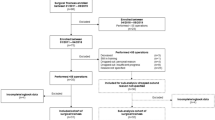Abstract
Background Laparoscopic techniques are increasingly used in common surgical procedures. Many of these procedures are used to teach basic surgical trainees (BST) and therefore introduction of these techniques may have implications for training.
Aims To establish whether the introduction of laparoscopic techniques reduced the opportunity of BSTs to perform surgical procedures.
Methods Patients undergoing hernia repair or appendicectomy in 1991 (when laparoscopy was first introduced) and 1997 (when laparoscopy was readily available) were identified using the Hospital In-Patient Enquiry (HIPE) database. The principal operator and whether the procedure was open or laparoscopic were identified by chart review.
Results The data showed a 50% reduction in the number of appendicectomies performed by BSTs following the introduction of laparoscopic techniques. The number of hernia repairs performed by BSTs has been preserved but the proportion by BSTs fell from 10 to 6%. The proportion of BST-performed procedures carried out laparoscopically has been reduced compared with the registrar-performed group.
Conclusions The use of minimally invasive techniques has had a negative effect on surgical training. Appropriate measures must be taken to minimise this and such measures should include a structured approach to laparoscopic training and greater access to laparoscopic training facilities.
Similar content being viewed by others
References
Vecchio R, MacFayden BV, Palazzo F. History of laparoscopic surgery.Panminerva Med 2000; 42 (1): 87–90.
Desgrosseillers S, Fartin M, Lokanthan R, Khouny N, Mulch D. Laparoscopic appendicectomy versus open appendicectomy.Can J Surg 2000; 38 (2): 178–82.
Chiarugi M, Buccianti P, Celona G, Decanini L et al. Laparoscopic compared with open appendicectomy.Eur J Surg 1996; 162 (5): 385–90.
O’Riordain D, Kelly P, Horgan PG, Keane FBV, Tanner WA. Laparoscopic extraperitoneal repair in the day-case setting.Surg Endosc 1999; 13 (9): 914–17.
Swanstrom LL. Laparoscopic Hernioraphy.Surg Clin North Am 1996; 76 (3): 483–91.
Monson J. Advanced techniques in abdominal surgery.BMJ 1993; 307: 1346–50.
Scott-Connor CE, Hall TJ, Anglin BL, Muakkass FT. The integration of laparoscopy into a residency and implications for training environment.Surg Endosc 1994; 8 (9): 1054–7.
Botha AJ, Elton C, Moore EE, Suaven P. Laparoscopic appendicectomy: a trainee’s perspective.Ann R Coll Surg Engl 1995; 77 (4): 159–62.
Navez B, Penninckx F. Laparoscopic training: results of a Belgian survey in trainees.Acta Chir Belg 1999; 99 (2): 53–8.
Varghese D, Patel H, Varghese A. Surgical training for the next millennium.Hosp Med 1999; 60 (3): 210–11.
Greig JD, Duignan J. Sunderland Basic Surgical Skills Courses.BMJ 1996; 313: 1555.
Tsai CL, Heinrichs WL. Acquisition of eye-hand co-ordination skills for videoendoscopic surgery.J Am Assoc Gynael Laparosc 1994; 1: S37–40.
Derossis AM, Fried GM, Abrahamowicz M, Sigman HH et al. Development of a model for training and evaluation of laparoscopic skills.Am J Surg 1998; 175 (6): 482–7.
D e rossis AM, Fried GM, Bothwell J, Sigman HH. The effect of practice on performance in a laparoscopic simulator.Surg Endosc 1998; 12 (9): 1117–20.
Mori T, Maruyama S, Atomi Y. Significance of hands-on training in laparoscopic surgery.Surg Endosc 1998; 12 (3): 256–60.
Varghese D, Patel H. An inexpensive and easily constructed box simulator.Hosp Med 1998; 59 (10): 769.
Gallagher AG, McClure N, McGuigan J, Crothers I, Browning J. Virtual reality training in laparoscopic surgery.Endoscopy 1999; 31 (4): 310–13.
Society of American Gastrointestinal Endoscopic Surgeons. Integrating advanced laparoscopy into surgical residency training.Surg Endosc 98; 12: 377.
Author information
Authors and Affiliations
Corresponding author
Rights and permissions
About this article
Cite this article
McCormick, P., Tanner, W., Keane, F. et al. Minimally invasive techniques in common surgical procedures: Implications for training. Ir J Med Sci 172, 27–29 (2003). https://doi.org/10.1007/BF02914782
Issue Date:
DOI: https://doi.org/10.1007/BF02914782




